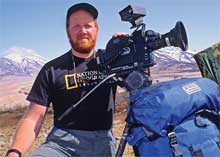
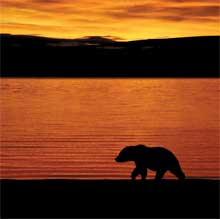
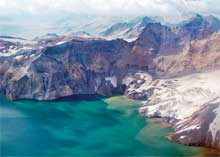
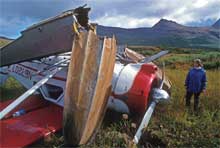
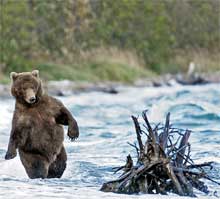
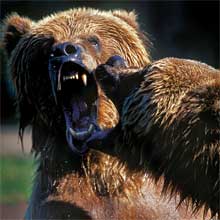
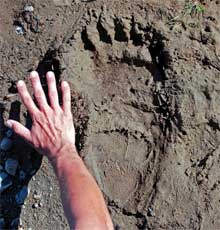
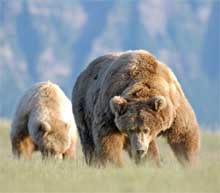
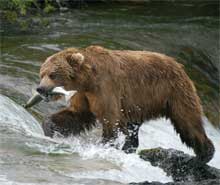
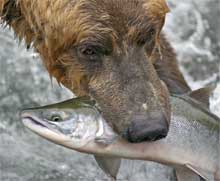
By JoAnn Guidry * Photography By Mark Emery
After surviving a harrowing plane crash in the Alaskan wilderness, there aren’t many people who would then decide not to be rescued.
Meet wildlife cinematographer Mark Emery. His explanation of that decision is simple, revealing much about the lifelong outdoorsman who grew up in Ocala.
“We didn’t get there exactly as we’d planned,” recalls Mark, “but we were where we wanted to be.”
Emery and his wife Mary were being flown in a float plane to a small lake 100 miles from the tiny fishing community of King Salmon, Alaska. King Salmon, population 225, is home base for the Emerys from May to late September. For the past 23 years, Mark has been a fishing/eco-tour guide when he isn’t making wildlife films for National Geographic Television and The Discovery Channel. Mary works for the Alaska Department of Fish and Game.
When their busy work season is over, they generally take their vacation. They planned to camp near the isolated lake and spend a week fishing and hiking to their delight.
“The weather was normal for an Alaskan day,” recalls Mark. “Rainy and windy, with periods of sun. The lake we were headed to is surrounded by cliffs and right off the Pacific coast. This makes it a perfect wind tunnel and a very tricky place to land, even for an experienced pilot.”
AND MOTHER NATURE USUALLY trumps man’s experience every time. The float plane had actually made contact with the lake when gusting winds from behind sent it airborne again. There
was no way, even for an experienced pilot, to maintain control.
“We were sent speeding toward the shoreline,” says Mark. “My last glance at the speedometer told me we hit land at 70-80 miles an hour. The plane flipped and we landed upside down 20 yards from the lake shore.”
The quick-thinking pilot shut down the engine before the crash, saving them from being trapped in a burning plane. But strapped into their seat belts, they were hanging upside down in the plane. Fuel was flowing out of the broken wings into the plane’s cabin.
Mary and the pilot managed to safely unbuckle their seat belts and crawl out, while Mark, who had been in the rear of the plane, was still trapped.
“I started off loading our supplies through a space large enough for that, but too small for me,” says Mark, a former kick-boxer who is 6-4 and weighs a muscular 240 pounds. “Mary is yelling at me to get out because she was afraid the plane might still explode. I was thinking more about having to spend the night in a gas-soaked tent.”
After unloading the supplies, Mark finally managed to squirm out of the plane safe and sound. Not only was the plane a crumpled heap of broken wings and snapped floats, but the radio had also been soaked in fuel and was inoperable. They were able to salvage an electronic tracking device, which would send out a signal to passing satellites monitored by the U.S. Coast Guard, although there was no certainty the device would work from the canyon lake.
The group’s luck held out. After spending a night in grizzly bear country, their tent being battered by 60-mile-an-hour winds, a Coast Guard plane confirmed their location mid-morning the next day. A rescue plane would soon follow.
“Mary and I decided we still wanted to have our vacation,” says Mark. “We packed up our gear, left the pilot to be rescued, and told him to come back and get us in a week. We hiked up to a pass, watched the pilot being picked up, and then had a great vacation in some of the most beautiful country in the world.”
THE PLANE CRASH TALE is just one of too many to recount in a lifetime of adventures for Mark Emery. He has traveled throughout the world — from Alaska to Zaire — filming grizzly, moose, wolves, caribou, spawning salmon, lions, elephants, alligators, and crocodiles. In addition to surviving a plane crash, he has been bitten by alligators and rattlesnakes, kicked by an emu, charged by grizzly bears, and contracted Lyme disease after crawling into an alligator den on a tick infested island.
Growing up in Ocala, Mark, now 52, was a born outdoorsman with fishing his earliest passion. He kept a detailed fishing diary as a 12-year-old, documenting the best places to catch a variety of fish. Beneath his mattress, he hid outdoors magazines, read about the adventures of Joe Brooks, A.J. McClane and Erwin Bauer, and dreamed of a magical place called Alaska.
“My parents were both classically trained musicians. My father and mother sang in choirs directed by Leonard Bernstein, and my mother taught piano,” says Mark. “My father, as well as Ocalan Trusty Drake, helped fuel my interest in the outdoors.”
And he pursued it with a passion.
MARK WORKED AT SILVER SPRINGS ATTRACTION, wrestling alligators, milking snakes and watching photographer Bruce Mozert. Then there was a stint of managing the fishing department at Bill Ray’s Sports City.
“I was working at Sport City and guiding fishermen on the weekends,” says Mark. “Then one day Bill Dennis, who had grown up in Dunnellon, came by the store. He was now a detective in the Anchorage Police Department and told me about a lodge in Alaska that was looking for a fishing guide.”
As a boy, Mark had read and dreamed about fishing in Alaska.
“I didn’t have to be asked twice,” he says. “It was 1983 and I’ve been there ever since.”
Establishing himself as a fishing guide, Mark quickly gained a reputation as a superb outdoorsman. Combined with his photography background, it was a perfect fit when companies such as Fuji began coming to Alaska in the mid-eighties to shoot films about wildlife. Mark served as a location scout and began guiding film crews into the backcountry. He knew all the best places to get footage of bears, wolves, moose, and caribou.
The Alaskan brown bear, more commonly known as the grizzly bear, particularly attracted the filmmakers and Mark knew where to find them. And not just when they were in plain sight along the Brooks River during the height of salmon season, but in lesser-known locales where they could be filmed doing more than just eating fish. Mark had made it a point to learn all he could about the bears, from talking with biologists to gaining personal observations and experiences.
SOME OF THE KNOWLEDGE about bears he has gleaned includes this: “When salmon arrive in numbers, bears are so focused on fish that they are, for the most part, just interested in the fish and not in you,” says Mark. “On the other hand, if a bear has killed a moose, which is a very difficult kill for them, they defend it very aggressively. That’s a situation where people can get hurt or even killed.”
And there’s this tidbit: “When bears are uncomfortable with a situation, they yawn,” he says. “It’s bear body language that says you’re too close and
it can be followed by
a charge.”
Describing a grizzly as “the size of a compact car covered with shag carpet,” Mark says these beasts “are at the top of the Alaskan food chain and the masters of intimidation.”
A favorite filming spot is Katmai National Park, a 4.1-million acre park that is home to the largest concentration of grizzlies in the world. How many? Approximately 1,500 at any given time. Before the bears feast on salmon in the summer, Mark says they “graze like cattle.”
It would be the Katmai National Park and how it was created by nature that gave Mark his first major breakthrough as a filmmaker. Over the years, he had made contacts that he credits freely with advancing his career. He’d met writer/editor Parker Bauer, son of his childhood hero Erwin Bauer; filmmakers Jordan Klein and his son Jordy; and wildlife cinematographer Steve Maslowski. He became involved with them in film projects, working on the production crews behind the camera. And his inherited musical talents came into play as he began writing and producing soundtracks for the nature films. He and Tracy Collins have been partners in the latter endeavor for 20 years.
AS HIS EXPERIENCE IN CINEMATOGRAPHY GREW, Mark began to look for a project he could take a bigger role in. That breakthrough came in 1990 when he and Maslowski got the go-ahead from National Geographic Television for the film project The Valley of Ten Thousand Smokes. It would document the world’s largest rhyolitic eruption in 1912, its long-standing effect on the area’s ecosystem, and the creation of Katmai National Park.
Mark and Maslowski spent two seasons climbing up and down remote volcanoes, as well as filming bears and salmon. Mark and Collins also wrote the soundtrack for the film, which first aired
in 1994.
“It was the most amazing time of my life,” says Mark. “I never thought that a kid from a small town in Florida would be given a chance to do a film for National Geographic.”
MARK’S BODY OF WORK continues to grow. To date, he has written the soundtrack for 160 television shows, as well as six major films for National Geographic Television and The Discovery Channel. He acted as producer/director of The Seasons of the Salmon, which he co-scored with Collins. Parker Bauer wrote the script for the film, which first aired on National Georgraphic Television in 1997.
In 1996, Mark become involved with One More Cast with Shaw Griggsby, a fishing show that currently airs on Versus Network. Mark directs shoots and co-produces the show’s soundtracks
with Collins.
Mark has also been involved in three high-definition television shows currently airing or that will air in the spring on the National Geographic Channel. The shows include Deadly Dozen of North America, Gators vs. Pythons, and Planet Carnivore, Mountain.
Also known for his stunning still photography and outdoor writing, that part of Mark’s resume is impressive as well. His photos and articles have been featured in such publications as National Geographic Magazine, The London Times, Newsweek, Outside Magazine, Florida Sportsman, Angling Adventures, and Alaska Magazine.
Mark and Mary, who, not surprisingly, met 20 years ago in Alaska, split their time between Alaska, Ocala, and traveling to assignments around the world. From May to late September, they’re at their home in King Salmon, which is 300 miles from the nearest connecting highway. The rest of the year, they’re in Ocala. If you’re wondering why they don’t stay in Alaska year-round, the answer is the Alaskan winter of gale-force winds, temperatures that can dip to minus 50 degrees, and days with only four hours of sunlight.
“It’s really good to have Ocala to come back to,” says Mark. “I love Alaska, but the winters here are much more hospitable.”
Several rooms in the Ocala home are devoted to Mark’s profession. There’s a music production studio, rooms with filing cabinets full of slides, cameras, tripods, and camping equipment. The walls are decorated simply with large photos of Mark’s favorite wildlife pictures. On the coffee table and in the bookshelves are books about animals, countries, national parks. Outside, a fishing boat is at the ready in the driveway. There is no mistaking that this is the home of people who love the outdoors.
Mark Emery is living the life he dreamed of as a kid. His childhood love affair with the outdoors has not only provided him with a livelihood, it has also given him riches beyond monetary standards.
“Wealth to me has always been directly related to the amount of time I can spend outdoors,” says Mark. “Most of my life has been spent in the thick of the riches.”
Survival Tidbits From Mark Emery
• “When salmon arrive in numbers, bears are so focused on fish that they are, for the most part, just interested in the fish and not in you.”
• “On the other hand, if a bear has killed a moose, which is a very difficult kill for them, they defend it very aggressively. That’s a situation where people can get hurt or even killed.”
• “When bears are uncomfortable with a situation, they yawn. It’s bear body language that says you’re too close and it can be followed by a charge.”
• “The grizzly is the size of a compact car covered with shag carpet.”
Want To Know More?
www.markemeryfilms.com






